 Abraham Lincoln
If given the truth, the people can be depended upon to meet any national crisis...
Abraham Lincoln
If given the truth, the people can be depended upon to meet any national crisis...
 Guildford news...
for Guildford people, brought to you by Guildford reporters - Guildford's own news service
Guildford news...
for Guildford people, brought to you by Guildford reporters - Guildford's own news service
Marking 100 Years of Buses on the Guildford to Horsham Route
Published on: 6 Apr, 2023
Updated on: 7 Apr, 2023
One hundred years ago, on April 9, 1923, motor-buses began running from Guildford to Horsham and back. Here, bus historian and enthusiast Gerry Bixley tells the colourful story of this route, its changes and developments over the years.
The railway boom of the mid-19th century eventually led to a line connecting Guildford and Horsham.
Lines were built by speculators, who in this case expected the principal traffic to be from the Horsham end, but this was not to be.
Passengers were in the minority with goods trains prevailing, notably carrying coal and agricultural products. Moving horses was also good business.
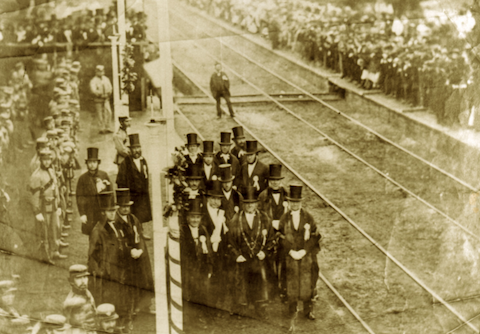
A photo of Guildford railway station that is believed to have been taken on the day in 1865 when the Guildford to Horsham railway line was opened.
The railway line opened in 1865 when roadways were often tracks traversed by horse-drawn carts.
In the 1920s the Aldershot & District bus company was expanding its routes and Guildford was part of its plans with services to Woking, Haslemere, Petersfield, Dorking and Farnham, and of course Aldershot.
These were identified by buses pained green and cream in colour.
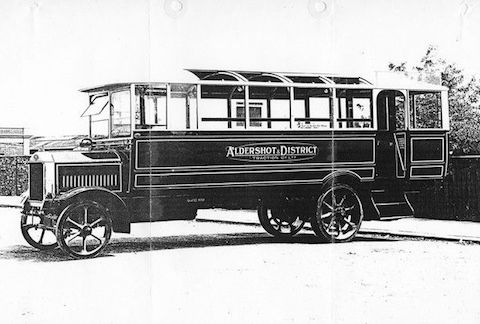
The first type of buses Aldershot & District used on the Guildford to Horsham route.
On April 9, 1923, the company commenced running from its Guildford Technical Institute bus stop in Park Street, to Horsham. The route went by Shalford, Bramley, Grafham, Pains Hill, Alfold, Bucks Green, Slinfold, Broadbridge Heath and terminating at Horsham Carfax.
This became what we know know as the A281, but originally the road passed through what is now the site of Dunsfold Aerodrome. The road was bypassed during the Second World War to allow for runway expansion of the airfield.
In the beginning, there were six return journeys weekdays and four on Sundays, with a journey time of one hour and 42 minutes.
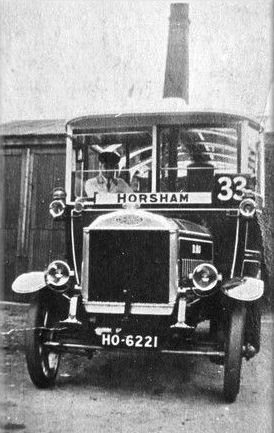
One of the first buses, with solid tyres. on the Guildford to Horsham route.
All buses had solid tyres and were restricted to a speed of 12mph.
The first bus left Guildford at 9.15am and the last at 9pm, and at 8pm on Sundays.
Two buses were required to work the service, one based at Guildford and the other at Horsham. A single journey cost two shillings and sixpence.
In 1927 the buses were required to be updated with pneumatic tyres, and although this took place, it was not until 1929 before the journey time was reduced to one hour and 15 minutes.
The train fare was two shillings and sixpence, but the time taken was one hour and 13 minutes.
The chassis of these first buses on the route appear to have been made by Dennis Bros of Guildford. They had 36-seat bodies made by the London firm of Strachan & Brown. Seats were smaller and closer to one another that what is acceptable now.
In 1930 the original vehicles were replaced by Dennis Bros buses of a later design with larger seat spacings. Updating vehicles was a continuous process, with 32-seat capacity the norm for the next 20 years.
In 1950, Aldershot & District took advantage of legislation changes which allowed larger buses, and 38-seaters were introduced, followed in 1954 by 43-seat underfloor-engined vehicles.
These were of the AEC make for a change, it being decided that no type of bus made by Dennis Bros for this route was now suitable.
In fact, ever larger vehicles continue to be produced to this day, all single deck type. However, single deckers were needed on the Guildford to Horsham route due to a low railway bridge at Rudgwick. That was until 1966, when the redundant bridge was demolished.
Back in 1926, Gastonia, a Cranleigh bus company, started running buses to Guildford, and from 1929 from Cranleigh to Horsham via Baynards and Rudgwick village itself.
In 1930, the Aldershot & District’s Guildford to Horsham, route, by then known as number 33, was changed to run via Cranleigh and the village of Rudgwick.
The full route now took one hour and 26 minutes.
The fare for a single from Guildford to Horsham was now two shillings, and the eight return journeys were supplemented by a Saturday evening journey. This took place after the last performance of the night at Guildford’s Theatre Royal in North Street. The bus ran from Guildford as far as the Leathern Bottle pub, just past Bramley.
In 1928, alternative journeys between Bramley and Cranleigh were diverted via Run Common and numbered 33A.
By this time passengers were being encouraged to travel from Guildford through to the Sussex coast, by changing to a Southdown bus company vehicle at Horsham. A single ticket was made available to cover the entire journey.
The 33s were very busy during the Second World War years and immediately afterwards.
A particular day was recorded on Whit Monday 1948 when 917 returning passengers joined Guildford-bound buses at Horsham for the six journeys between 4.25pm and 9.15pm, squeezed into 20 vehicles.
Aldershot & District often had to enlist Southdown’s buses at Horsham to help shift the crowds of passengers.
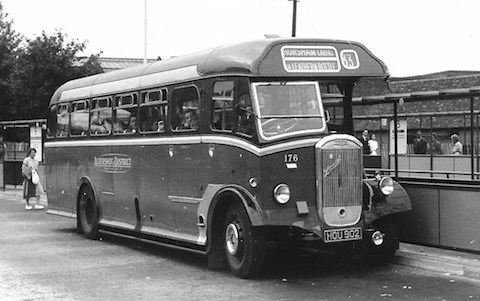
The type of bus used by Aldershot & District on route 33, Guildford to Horsham, pictured at Guildford’s Farnham Road bus station in the late 1950s / early 1960s.
In 1953, a day ticket to Brighton and back cost six shillings and sixpence, or six shillings for a return to Worthing. All this before the days of mass car ownership.

It’s June 12, 1965 and he last scheduled passenger train from Guildford to Horsham is about to depart. Picture: Geoff Burch collection.
The Guildford to Horsham railway line closed in June 1965, just missing its centenary by a few months.
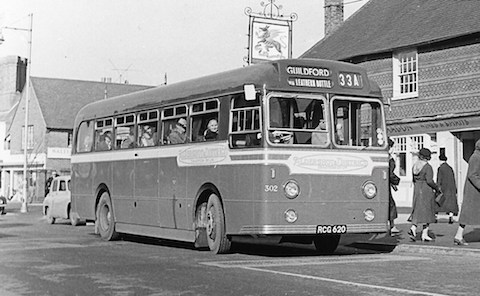
An Aldershot & District bus pictured at Horsham in about the early 1960s.
Extra buses were then laid on, but the railway’s former customers made relatively little use of the enhanced bus services.
At the end of 1971, Aldershot & District lost its individual identity by being incorporated in the Alder Valley bus firm, as created by the nationalised bus company in the UK. This lasted until 1984.
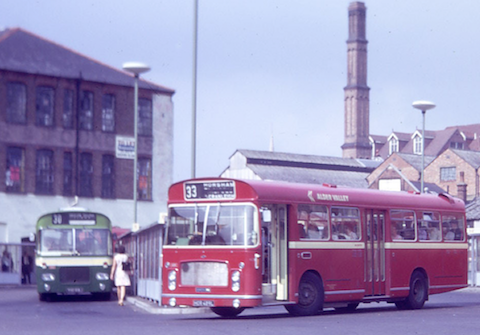
An Alder Valley bus on the 33 route, Guildford to Horsham, pictured at Guildford’s Onslow Street bus station.
Under Alder Valley, the buses lost their distinctive green and cream livery, to be replaced by an orangey-red and white livery.
The service number was changed from 33 to 283 and then followed various ownership changes causing a re-naming to Alder Valley South, then Alder Valley West Surrey, until 1988 when the 283 became number 63. By this time, the number 33 had been used by anther bus company.
A further re-naming to Guildford West Surrey, that lasted until 1990, restored a basically green livery to its fleet of buses.
Then came Arriva, Guildford and West Surrey, with its blue and white buses. Lastly, in 2021, Stagecoach South took over the Guildford operation.

On Wednesday, April 5, 2023 the 10.20am Stagecoach South bus leaves Guildford bus station for Horsham.
Service number 63 still survives with multi-coloured buses of various styles. Today, the route deviates at Bramley, through Wonersh and Shamley Green, before continuing to Rudgwick and beyond.
Currently, journey times from Guildford to Horsham are around one hour 14 minutes, and at present there is a special maximum one-way fare of £2.
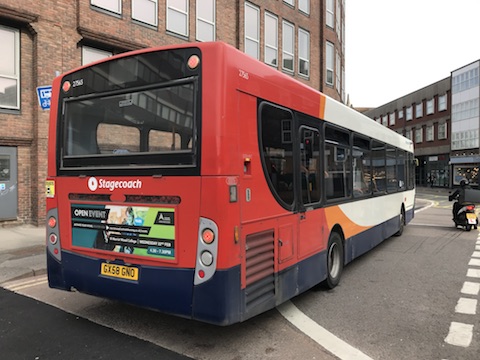
Off to Horsham goes the number 63.
Recent Articles
- Guildford Institute’s Crowdfunding Project for Accessible Toilet in its New Community and Wellbeing Centre
- Letter: Guildford – Another Opportunity Missed?
- Letter: GBC’s Corporate Strategy – Where Is the Ambition?
- My Memories of John Mayall at a Ground-breaking Gig in Guildford Nearly Six Decades Ago
- Westborough HMO Plans ‘Losing the Heart of the Street’ Says Resident
- College Invests to Boost Surrey’s Economy and Close Digital Skills Gap
- Community Lottery Brings Big Wins for Local Charities
- GBC Housing Plan Promises ‘A Vibrant Urban Neighbourhood’ Near Town Centre
- Hospital Pillows ‘Shortage’ at the Royal Surrey
- Updated: Caravans Set Up Camp at Ash Manor School


Search in Site
Media Gallery
Dragon Interview: Local Artist Leaves Her Mark At One of England’s Most Historic Buildings
January 21, 2023 / No Comment / Read MoreDragon Interview: Lib Dem Planning Chair: ‘Current Policy Doesn’t Work for Local People’
January 19, 2023 / No Comment / Read MoreA3 Tunnel in Guildford ‘Necessary’ for New Homes, Says Guildford’s MP
January 10, 2023 / No Comment / Read More‘Madness’ for London Road Scheme to Go Ahead Against ‘Huge Opposition’, Says SCC Leader
January 6, 2023 / No Comment / Read MoreCouncillor’s Son Starts Campaign for More Consultation on North Street Plan
December 30, 2022 / No Comment / Read MoreCounty Council Climbs Down Over London Road Works – Further ‘Engagement’ Period Announced
December 14, 2022 / No Comment / Read MoreDragon Interview: GBC Reaction to the Government’s Expected Decision to Relax Housing Targets
December 7, 2022 / No Comment / Read MoreHow Can Our Town Centre Businesses Recover? Watch the Shop Front Debate
May 18, 2020 / No Comment / Read More









Recent Comments